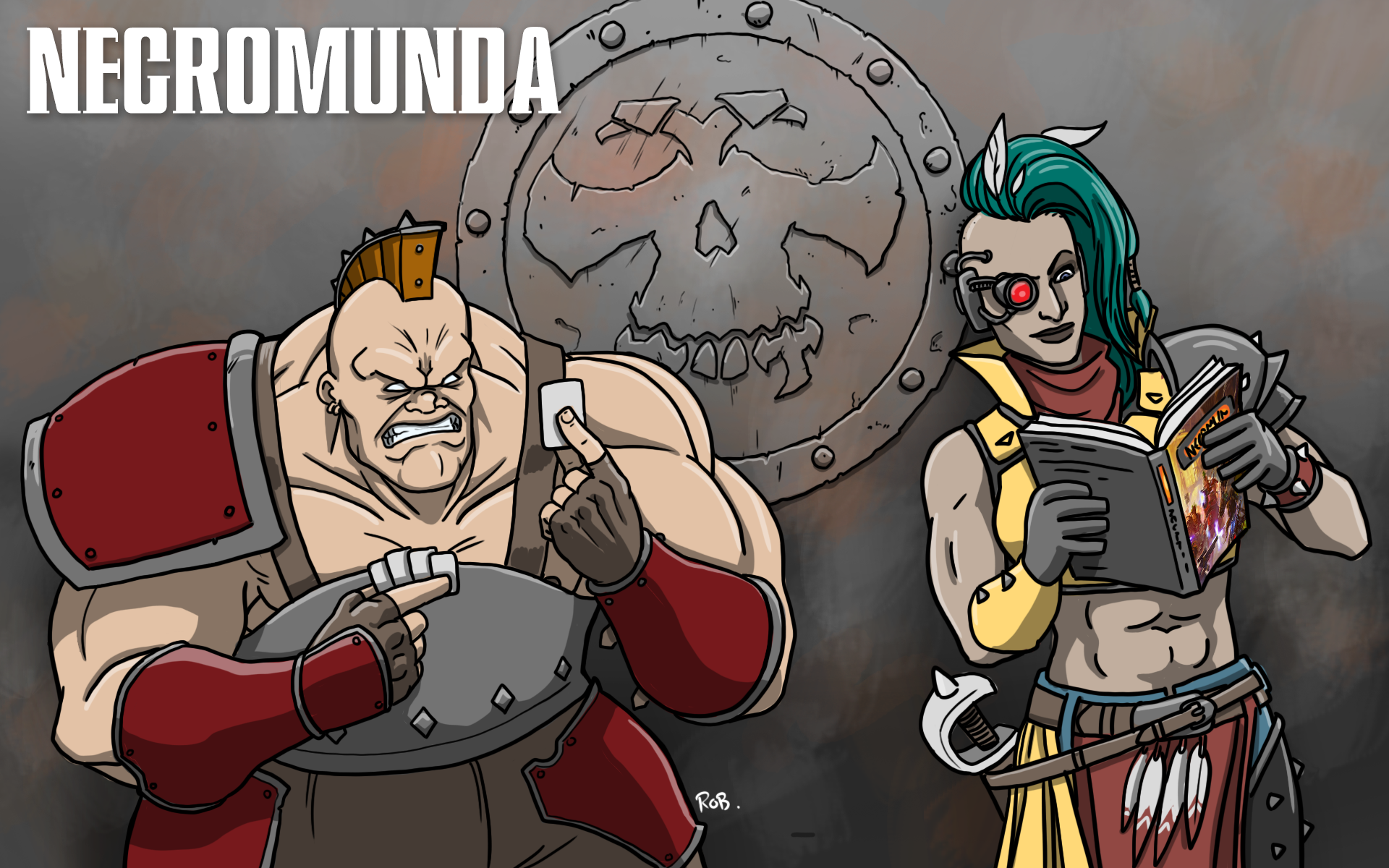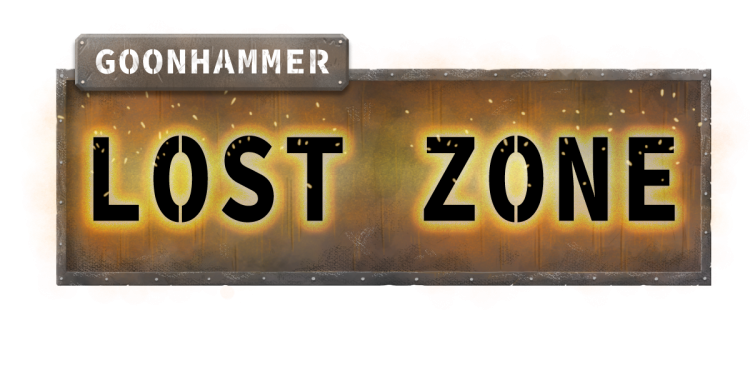Over the last few weeks we’ve been hard at work creating content for THE LOST ZONE, a Necromunda mod of sorts that strips down gang resources and rebalances the Campaign with the goal of making things seem more desperate and threadbare. But what if you want to spice things up without throwing out everything? Today I’m going to present a simpler alternative that can still leave you with an improved experience.
The Case for Simpler House Rules
If your gaming group is anything like mine, it can be difficult to ‘sell’ them on sweeping house rule sets like Goonhammer’s very own Lost Zone. First off, some players may prefer the well-equipped and varied gangs of new-school Necromunda. Especially if they’ve gone to the effort of lovingly converting whatever exotic xenos weapons or esoteric equipment they fancied. Who can look a Van Saar player in the eye and tell him not to use that Servo-Harness & Multi-Melta model? It would take a heart of stone.
On a more prosaic level, lots of groups default to a ‘Rules as Written’ (RAW) standard. GW-published books may have their fair share of errata, typos, confusing rules or bizarre balance decisions. But to most people they are the fundamental law of the game, they have an assumed authority and there will be a resistance to deviating from that commonly-accepted standard. Extensive House Rules sets are fine for tightly-knit groups which have played together for a long time. But in the real world, most players will be highly aware of the standard game rules, from poring over the books privately and/or reading discussion of the game online. They may want to play (even using the same gang) with other groups or individual friends between games of your campaign. All this means players can sensibly want to ‘stick to the rules’.
Finally there is a practical reason to, if not go RAW, at least keep House Rules very simple. Necromunda already requires a long list of books to cover every aspect of gangs, rules and scenarios. Adding even more additions and extra mechanics can further overburden players. This is not to disparage Lost Zone’s scarcity mechanics – but not every group will be fully engaged with so many extra rules. Many players just want simplicity.
So without further ado…
How to Use this Article
So, here is a suggested list of ‘quick fix’ House Rules which can be used to impart an old-school Necromunda, ‘Lost Zone’ flavour to any campaign, while letting your players mostly rely on the published books. A simple way to use them would be to agree with the campaign group which to use – it’s not an all or nothing deal, you may wish to adopt some house rules and not others – then give everyone a sheet of paper listing them (to be tucked into their rulebook or behind their gang roster) at the first game. Or display the digital equivalent on your WhatsApp/Facebook group or Google Docs page, or whatever you’re using to run your campaign. The point is the total changes to the book-derived campaign rules should be simple enough to fit on a sheet of paper – no tables, references, branching instructions etc.
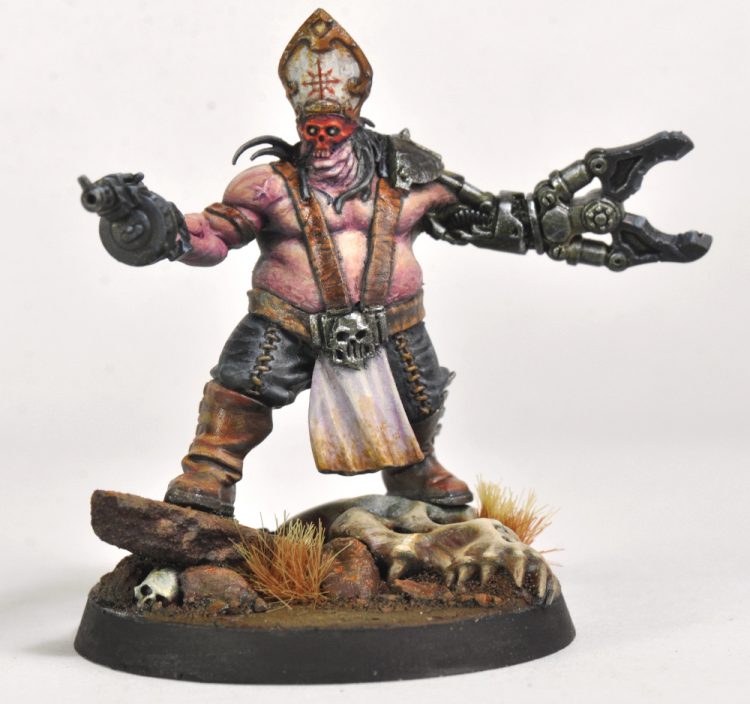
Controlling Access to Rare Equipment
A big difference in the feel of a campaign between old-style, or Lost Zone, and new-style Necromunda is how common special, heavy and exotic weapons are. The Rarity system at the Trading Post or Black Market isn’t really that restrictive. Between bonuses for multiple champions trading, reputation bonuses, and anything else from skills, kit, hangers-on etc, you can easily roll high, then go to town buying most anything you want. Here are some ideas to throttle that back:
- Rarity Roll = 1 Item of up to that Rarity
A simple fix (and the way some new players assume the rule is supposed to work) is that when visiting the Trading Post or Black Market, you roll for Rarity, then you can buy one item of up to that Rarity level – not as many items as you please!
- Trade Actions do not stack the +1 to the Rarity roll
If using the 1-item limit, you can rule that each Leader or Champ trading has to roll separately, and each can buy one item – no pooling your +1-2 bonuses for a hefty +4 to the roll after a successful game.
- Restrict Purchases from the House Equipment Lists
The above rules limiting Trading Post purchases can be a bit meaningless if Gangs are still buying freely from their House equipment available in Gangs of the Underhive or their own ‘House of’ book. You’d end up with more rigidly themed, but still very heavily equipped fighters. I would be careful in cutting players off from that equipment – it might be seen as unfair or punishing, since buying from the list at recruitment is seen as the inborn right of all House members. Here are some potential ideas to discuss with your group:
- House Equipment may only be purchased on Recruitment
By only allowing new fighters to come in with that flashy House kit, you are forcing players to choose between buying well equipped fighters, or getting some help in when they need it
- House Equipment may only be purchased during Campaign Downtime
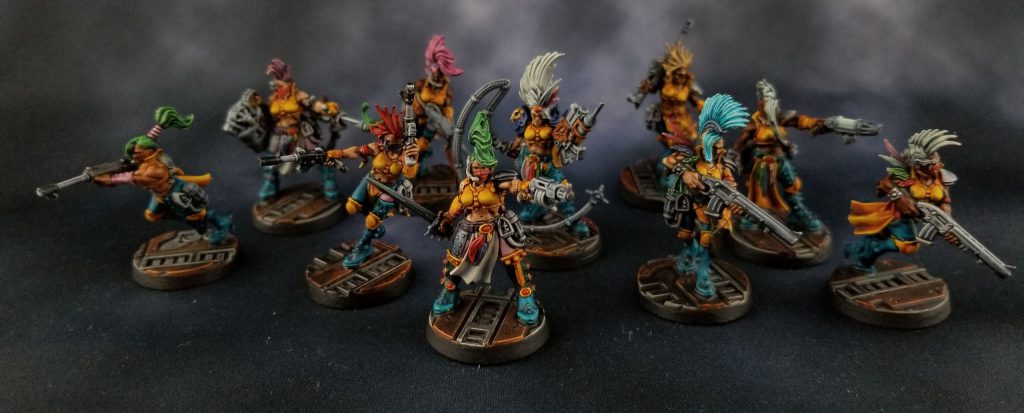
Limiting Gang Rosters
Old-style Necromunda had rules choking back your income if you had more fighters, representing the cost of feeding and maintaining a larger group. Gang size isn’t really an issue in Necromunda now, because Crew size is almost always limited, you get diminishing returns over 10 models. You could easily limit that if you want, of course, just say that no Gang can exceed X models. A more common issue is gangs stacking up multiple Champions and Brutes. This can reach a point where a custom-selected, rather than random, Crew can consist entirely of these powerful models, rendering common Gangers and Juves powerless. RAW, some campaign types don’t even place any limit on the number of champions you can recruit! The only limit from more recent books, that half your fighters must be Gangers, Juves or Prospects, is very forgiving. A gang with 12 fighters could have 4 Champions and a Brute, which together with a Leader and at least one Specialist, means the elite will dominate many scenarios. If that’s a problem, try this:
- No Gang may recruit more than 2 Champions & 1 Brute. If Champions die or are retired, Gangs may recruit to replace them, up to their max of 2. Prospects who promote to Champion from gaining Advancements may still take the total number of Champions above 2.
The intent here is to ensure that Champions and Brutes are still leaders and individual powerhouses, not the bulk of a gang’s fighting power! Promoting from within is still allowed, as without that exception, it would always be better to buy a fresh Champion than have a promoted Prospect with some glaring stat weaknesses and an inflated cost.
If you think this House Rule is too limiting – for example, some of your players may have lovingly modelled 3 or 4 cool Champions, and want to use them – consider raising the limit at Campaign Downtime, or at key Reputation milestones. Just ensure it doesn’t let one gang run away from the others.
- Any Crew chosen using Custom Selection must include half its number (rounding up) of Gang Fighters. E.G. when choosing 7 models as your Crew for a Scenario, 4 would have to be Gangers, Juves or Prospects, meaning you could have no more than 3 Champions or Brutes.
This alternate rule (you could use it together with the selection above if you like for an even more pronounced effect) stops players loading smaller-Crew Scenarios with exclusively their A-Team. That situation may not be a problem in your group – in some ways it’s very thematic and cool that for an important job, a Gang Leader would bring along his inner circle. But it can further weight the advantage of Custom Selection in Scenarios and let a strong gang bully one which is badly hit by Recovery or casualties. Think about whether this rule is necessary in your group, it could be replaced by a sensible word from the Arbitrator where appropriate. It could even be applied to Random Crew Selection Scenarios, by forcing players to re-roll until they had a ‘valid’ composition, but that would be more cumbersome.

Limiting Problematic Equipment
A common element in many gaming groups, from casual clubs to competitive leagues, is a ‘ban list’. Any arbitrator should be careful about banning things. You want to avoid it being seen as targeted at any one player or their gang. The key here would be discussion pre-campaign, or in an emergency when one particular item or weapon has derailed the whole thing. Decide on this before the first games are played, and get everyone to agree.
- Simple Banned Equipment Lists
List the items and include this info in the Campaign’s House Rules sheet. Suggestions would be Ablative Overlays or Falsehoods.
Some Arbitrators may consider this too rigid or unfun. Additionally, many items are thematic, powerful and cool as single purchases. They become an issue when spammed on as many suitable models as possible. There is of course a middle ground:
- Simple Limited Equipment Lists
List the items with the number any gang is allowed to take – typically just 1, but could be 2 or even 3. E.G. Cameleoline Cloak (1) – this item is powerful and opens up great modelling opportunities, but you wouldn’t want to face a shooting gang where everyone had one!
We would advise caution in banning or limiting items. It’s a top way to spoil a player’s fun when they’ve found something cool they want to try. If you’re not sure whether something will be unfun for the other players, have a word, let it ride for a game or two, and it may not actually be as big an issue as you thought. The first line of defence is cultivating an attitude in your gaming group against spamming the same weapons, or trying to break the game.
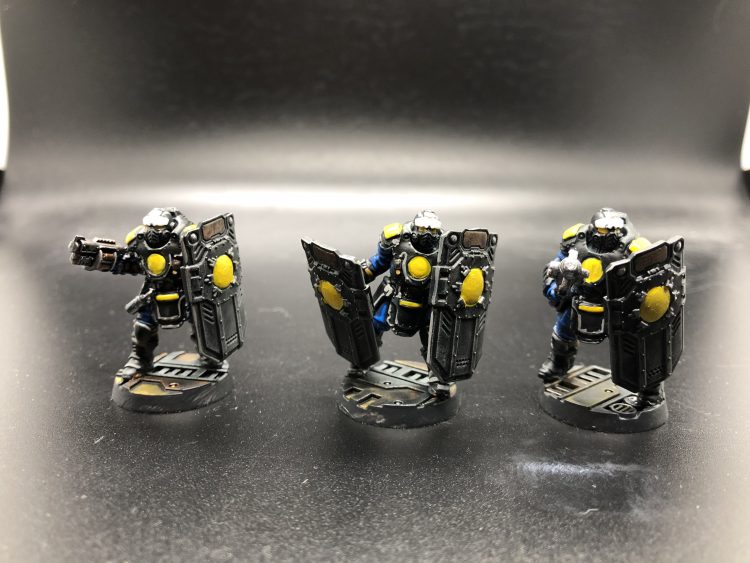
Making Skills More Interesting
A central point of Lost Zone is making Advancements a bit more interesting. Skills are very limited and certain stat increases tend to be favoured. Changing this up will breathe new life into gangs if their owners have used them in a couple campaigns already. But your players may not want to engage with new tables and custom-written Skills. Here’s a simpler, partial solution:
- Secondary and Primary Skills can be chosen as the free Skill on Recruitment.
Just let your Leader and Champions access that wider array of skills. Simple and opens up new options for builds.
- Choose a Primary Skill for 6xp; Choose a Secondary Skill for 9xp
There are several variations you could make to this – have both Primary and Secondary skills cost 6xp, or 9xp. Keep the option to roll randomly on either table for 6xp, perhaps with the option of re-rolling for Primary trees. The important thing is to have one line altering the Advancements available for skills, which can be included simply in your House Rules.
Work With Your Game Group
As always, things like this are a collaborative process – what’s important is that you and your play group decide on an approach that works for the type of campaign you want to play. The actual crunch of any of these proposed alternate rule sets doesn’t mean a thing if your group isn’t into it and conversely if you’re not having fun with the standard rules or want to try something new, don’t be afraid to bring it up and discuss it. Hopefully, if your gaming group doesn’t want a total conversion of the Necromunda campaign, but does want to tweak some aspects of the game, these rules will help.
Have any questions or feedback? Drop us a note in the comments below or email us at necromunday@goonhammer.com.
